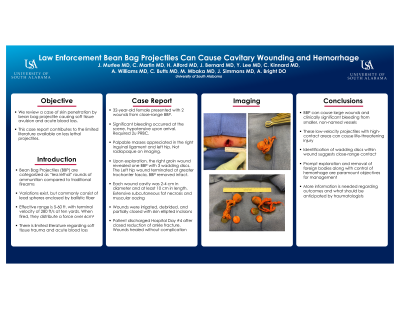Trauma
Category: Quickshot Oral Session 05
Quickshot Oral : Quickshot Oral Session 05
LAW ENFORCEMENT BEAN BAG PROJECTILES CAN PENETRATE AND CAUSE SIGNIFICANT TISSUE DAMAGE AND HEMORRHAGE
Saturday, February 11, 2023
3:00pm - 4:00pm East Coast USA Time

- JM
John Murfee, MD
United States
- JM
John Murfee, MD
United States
Presenter(s)
Principal Contact(s)
Objectives:
Introduction: Law enforcement agencies nationwide are increasingly using non-penetrating projectiles in an effort to incapacitate assailants without causing mortality. The most common projectile in this category is the bean bag round (BBR), which consists of a fabric “pillow” containing lead pellets and is fired from a 12-gauge shotgun. As more anecdotal reports have surfaced about the ability of these BBRs to penetrate the skin and cause significant injury, it is imperative that trauma surgeons understand the contents of BBRs and the necessity of removing all components when it penetrates into the patient. Herein, we present a case report and review of the literature regarding BBRs.
Cast Report: A 32-year-old female presented to our trauma center with two cavitary wounds located at the left hip and right lower abdomen from BBR projectiles. The BBR was fired from approximately 15 feet. The patient required multiple blood transfusions from significant hemorrhage during transport from the scene. On physical examination, there were large cavitary tracts that contained palpable masses at the end of the tracts. The lead contents of the BBRs could easily be seen on X-ray. The tracts were operatively explored and the BBRs were successfully removed, including the additional wadding discs (Fig. 1). Plain radiograph was performed to assure there were no retained pieces of the BBR. The cavitary wounds were approximately 15cm in length and was associated with significant tissue damage. The patient was subsequently discharged and the wounds healed without complication.
Conclusion: There is a paucity of published literature regarding the different types and the lethality of BBRs despite many anecdotal reports within the national news. BBRs can penetrate the skin causing clinically significant hemorrhage, tissue destruction, and death. The components of the BBR are not absorbable and as such it is imperative that all components must be surgically removed if penetration occurs. Future research should include national databases to determine the degree of non-lethality for each of the types of BBRs.
Methods:
Results:
Conclusion:
Introduction: Law enforcement agencies nationwide are increasingly using non-penetrating projectiles in an effort to incapacitate assailants without causing mortality. The most common projectile in this category is the bean bag round (BBR), which consists of a fabric “pillow” containing lead pellets and is fired from a 12-gauge shotgun. As more anecdotal reports have surfaced about the ability of these BBRs to penetrate the skin and cause significant injury, it is imperative that trauma surgeons understand the contents of BBRs and the necessity of removing all components when it penetrates into the patient. Herein, we present a case report and review of the literature regarding BBRs.
Cast Report: A 32-year-old female presented to our trauma center with two cavitary wounds located at the left hip and right lower abdomen from BBR projectiles. The BBR was fired from approximately 15 feet. The patient required multiple blood transfusions from significant hemorrhage during transport from the scene. On physical examination, there were large cavitary tracts that contained palpable masses at the end of the tracts. The lead contents of the BBRs could easily be seen on X-ray. The tracts were operatively explored and the BBRs were successfully removed, including the additional wadding discs (Fig. 1). Plain radiograph was performed to assure there were no retained pieces of the BBR. The cavitary wounds were approximately 15cm in length and was associated with significant tissue damage. The patient was subsequently discharged and the wounds healed without complication.
Conclusion: There is a paucity of published literature regarding the different types and the lethality of BBRs despite many anecdotal reports within the national news. BBRs can penetrate the skin causing clinically significant hemorrhage, tissue destruction, and death. The components of the BBR are not absorbable and as such it is imperative that all components must be surgically removed if penetration occurs. Future research should include national databases to determine the degree of non-lethality for each of the types of BBRs.
Methods:
Results:
Conclusion:

